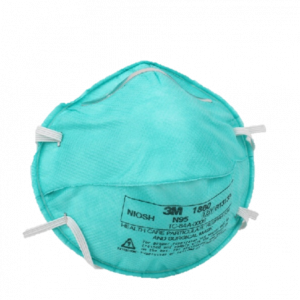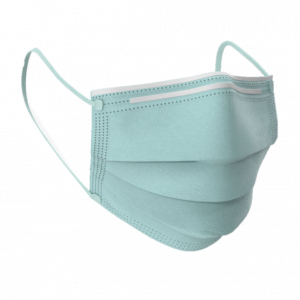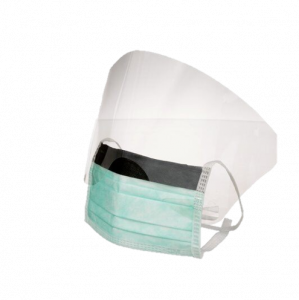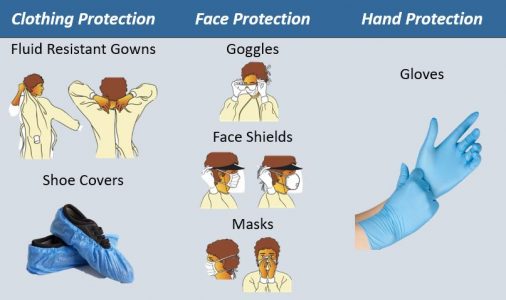Personal Protective Equipment (PPE), What is It?
Barriers used to protect the vulnerable areas of the body from infectious agents and help prevent the spread of pathogens.
Why Do We Need it?
To travel from person to person pathogens require a completed chain of infection. PPE is designed to break the chain.

Types of PPE: Clothing, Face and Hand Protection Items
How to Use PPE
Image: Modeled By Kimberly Perigrino & Ji Young Kim
Putting on PPE (DON)
- Make sure you have clean hands
- Put on the gown and secure it
- Put on mask – ensure a good seal
- Put on goggles or eye shield
- Clean hands again
- Put on gloves
Taking off PPE (DOFF)
- Make sure you have clean hands
- Put on the gown and secure it
- Put on mask – ensure a good seal
- Put on goggles or eye shield
- Clean hands again
- Put on gloves
TYPES OF PRECAUTIONS
Airborne Precautions
- Used for pathogens that transmit via airborne droplet nuclei or dust particles
- Example: Tuberculosis
Recommended PPE
- N95 respirator
- Fluid resistant gown
- Gloves
Droplet Precautions
- Used for pathogens that transmit via large infectious droplets
- which are generated by coughing, sneezing or talking
- Example: Rubella
Recommended PPE
- Surgical mask
- Fluid resistant gown
- Gloves
Contact Precautions
- Used for pathogens that transmit via direct contact or by contact with items in the patient’s environment
- Example: Methicillin-resistant Staphylococcus aureus (MRSA)
Recommended PPE
- Fluid resistant gown
- Gloves
COVID-19 Recommended PPE
- N95 respirator
- Surgical mask with face shield
- Fluid resistant gown
- Gloves
Interior Health. (2010, November). IS0500A: Tuberculosis. Infection Prevention and Control (Section 08S). Retrieved from https://www.interiorhealth.ca/AboutUs/QualityCare/IPCManual/Tuberculosis.pdf Government of Canada. (2020, February). Infection prevention and control for coronavirus disease (COVID-19): Interim guidance for acute healthcare settings. Retrieved from https://www.canada.ca/en/public-health/services/diseases/2019-novel-coronavirus-infection/health-professionals/interim-guidance-acute-healthcare-settings.html#a4 Mayo Clinic. (2019). MRSA Infection. Retrieved from https://www.mayoclinic.org/diseases-conditions/mrsa/symptoms-causes/syc-20375336 Robinson, R., Warekois, R.(2016) Phlebotomy Worktext and Procedures Manual. 4th Edition. Missouri. Elsevier.



